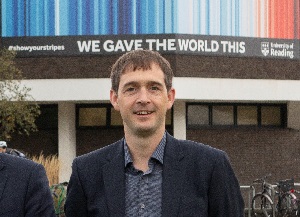MBE for professor who turned climate science into art
02 January 2020

The University of Reading and NCAS climate scientist behind a viral stripes graphic illustrating global temperature rise has been named in the New Year's Honours list.
Professor Ed Hawkins created the ‘climate stripes' in 2018, which have now been shared by millions of people and journalists around the world. He has published several high-profile studies into the effects and causes of climate change and helped the public engage with climate science through the citizen science project WeatherRescue.org, which asked the public to help transcribe hand-written historical weather observations to make them usable by climate scientists.
He was appointed an MBE for services to climate science and science communication in the New Year's Honours list for 2019.
'The climate stripes raise awareness of the substantial risks that climate change poses to people' -- Ed Hawkins MBE
Professor Hawkins said: "It is fantastic that the climate stripes have resonated with so many people around the world because it raises awareness of the substantial risks that climate change poses to people, society and the environment.
"I strongly believe in making science accessible to everybody, and am honoured that my efforts to do so have been recognised in this way."
The climate stripes show how average annual temperatures have risen since 1850, using shades of red and blue as an accessible way to indicate cooler or hotter years.
This summer, Professor Hawkins made climate stripes for almost every country and US state available to download for free from showyourstripes.info. More than a million people downloaded them in the first week, and they were widely used by television weather presenters, celebrities and bodies like the World Meteorological Organization.
'One of the most crucial images of our times'
Rock band Enter Shikari went one step further by using the global stripes as a backdrop for the main stage Reading Festival set in August, where lead singer Rou Reynolds described them as ‘one of the most crucial images of our times'.
The climate stripes were subsequently used on the front page of the Economist and the Guardian, as public interest in climate change increased and protests were held calling for action.
The stripes are not the only graphic created by Professor Hawkins to go global. A climate spiral animation, also illustrating global warming, was used in the opening ceremony of the 2016 Rio Olympic Games, reaching billions of people on television.
Professor Hawkins' other accolades include winning the Kavli Medal from the Royal Society in 2018 and the Climate Science Communication Award from the Royal Meteorological Society in 2016.
'Professor Hawkins [is] improving our understanding of the environment and helping make the world a better place for everyone' -- Professor Robert Van de Noort, Vice-Chancellor
Professor Robert Van de Noort, Vice-Chancellor of the University of Reading, said: "We are incredibly proud to see Professor Hawkins' work shared by millions of people across the globe and he deserves the highest plaudits for this great achievement.
"His hugely popular climate stripes are just one example of how he continues to present the latest climate science in an engaging way. Sustainability is a key part of everything we do at the University of Reading, and we recognise the work of Professor Hawkins and colleagues in improving our understanding of the environment and helping make the world a better place for everyone."
